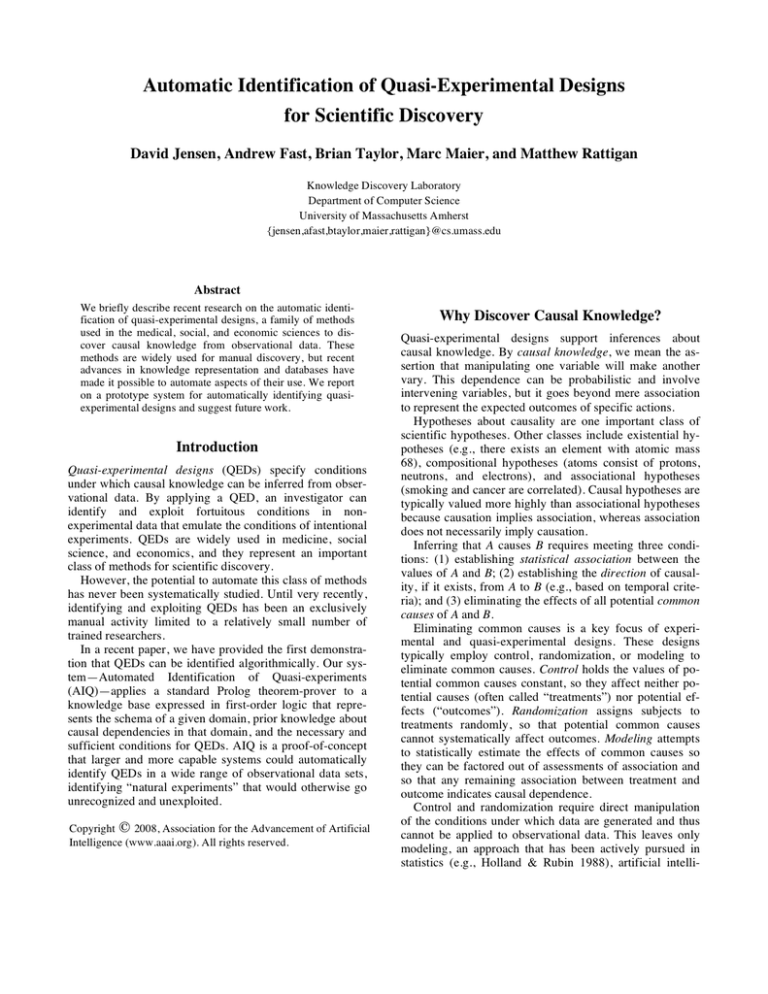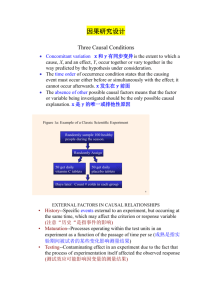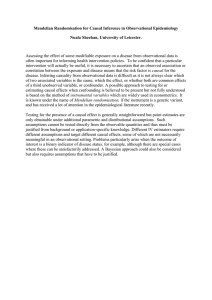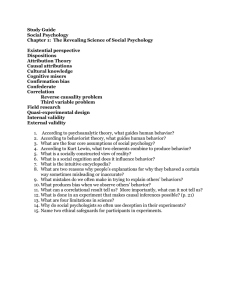
Automatic Identification of Quasi-Experimental Designs
for Scientific Discovery
David Jensen, Andrew Fast, Brian Taylor, Marc Maier, and Matthew Rattigan
Knowledge Discovery Laboratory
Department of Computer Science
University of Massachusetts Amherst
{jensen,afast,btaylor,maier,rattigan}@cs.umass.edu
Abstract
We briefly describe recent research on the automatic identification of quasi-experimental designs, a family of methods
used in the medical, social, and economic sciences to discover causal knowledge from observational data. These
methods are widely used for manual discovery, but recent
advances in knowledge representation and databases have
made it possible to automate aspects of their use. We report
on a prototype system for automatically identifying quasiexperimental designs and suggest future work.
Introduction
Quasi-experimental designs (QEDs) specify conditions
under which causal knowledge can be inferred from observational data. By applying a QED, an investigator can
identify and exploit fortuitous conditions in nonexperimental data that emulate the conditions of intentional
experiments. QEDs are widely used in medicine, social
science, and economics, and they represent an important
class of methods for scientific discovery.
However, the potential to automate this class of methods
has never been systematically studied. Until very recently,
identifying and exploiting QEDs has been an exclusively
manual activity limited to a relatively small number of
trained researchers.
In a recent paper, we have provided the first demonstration that QEDs can be identified algorithmically. Our system—Automated Identification of Quasi-experiments
(AIQ)—applies a standard Prolog theorem-prover to a
knowledge base expressed in first-order logic that represents the schema of a given domain, prior knowledge about
causal dependencies in that domain, and the necessary and
sufficient conditions for QEDs. AIQ is a proof-of-concept
that larger and more capable systems could automatically
identify QEDs in a wide range of observational data sets,
identifying “natural experiments” that would otherwise go
unrecognized and unexploited.
Copyright © 2008, Association for the Advancement of Artificial
Intelligence (www.aaai.org). All rights reserved.
Why Discover Causal Knowledge?
Quasi-experimental designs support inferences about
causal knowledge. By causal knowledge, we mean the assertion that manipulating one variable will make another
vary. This dependence can be probabilistic and involve
intervening variables, but it goes beyond mere association
to represent the expected outcomes of specific actions.
Hypotheses about causality are one important class of
scientific hypotheses. Other classes include existential hypotheses (e.g., there exists an element with atomic mass
68), compositional hypotheses (atoms consist of protons,
neutrons, and electrons), and associational hypotheses
(smoking and cancer are correlated). Causal hypotheses are
typically valued more highly than associational hypotheses
because causation implies association, whereas association
does not necessarily imply causation.
Inferring that A causes B requires meeting three conditions: (1) establishing statistical association between the
values of A and B; (2) establishing the direction of causality, if it exists, from A to B (e.g., based on temporal criteria); and (3) eliminating the effects of all potential common
causes of A and B.
Eliminating common causes is a key focus of experimental and quasi-experimental designs. These designs
typically employ control, randomization, or modeling to
eliminate common causes. Control holds the values of potential common causes constant, so they affect neither potential causes (often called “treatments”) nor potential effects (“outcomes”). Randomization assigns subjects to
treatments randomly, so that potential common causes
cannot systematically affect outcomes. Modeling attempts
to statistically estimate the effects of common causes so
they can be factored out of assessments of association and
so that any remaining association between treatment and
outcome indicates causal dependence.
Control and randomization require direct manipulation
of the conditions under which data are generated and thus
cannot be applied to observational data. This leaves only
modeling, an approach that has been actively pursued in
statistics (e.g., Holland & Rubin 1988), artificial intelli-
gence (Pearl 2000), and philosophy (Spirtes, Glymour,
Scheines 2000). While the developments to date in modeling have been impressive, and new developments continue,
the problem of causal discovery is far from solved. Problems of correct model specification, latent variables, computational tractability, and high sample complexity continue to constrain real-world applications of modeling.
Quasi-Experimental Designs
QEDs are a family of methods for exploiting fortuitous
situations in observational data that emulate control and
randomization (Campbell & Stanley 1963; Shadish, Cook,
and Campbell 2002). QEDs are templates for causal inference that increase the statistical power of inferences by
selecting subsets of data that reduce or eliminate some
common causes. QEDs bring back a form of control and
randomization to the analysis of non-experimental data,
and thus expand the range of approaches that can be applied to such data.
There are many examples of QEDs, including: (1) twin
designs which control the values of some potential common causes within specified pairs of data instances; (2)
non-equivalent control group designs which compare temporal responses of treated instances to a control group of
similar untreated instances; (3) regression discontinuity
designs which use cases in which treatment is assigned
entirely based on the value of a single known variable.
QEDs are particularly useful when experiments are
deemed unethical (e.g., studies of smoking and cancer in
humans), when experiments are impractical (studies of
how increased state penalties affect drunk driving), or
when data have already been collected for other purposes
and researchers want an inexpensive precursor to potential
future experiments.
Automatic Identification
Identifying opportunities to apply QEDs is currently a
painstaking manual process. It requires highly specific
knowledge of the domain, the available data, and QEDs
themselves. Despite the wide use of QEDs, many opportunities to apply these methods for causal discovery still go
unrecognized.
Fortunately, recent developments in the technologies
and applications of databases and machine learning present
new opportunities for automating the discovery of QEDs.
First, the increasing complexity of the relational and temporal structure of databases provides the necessary scope
for application of QEDs. Second, the increasing size of
databases provides the ability to identify subsets of data
with the necessary statistical power for valid causal inferences. Finally, recently devised relational and temporal
knowledge representations provide the ability to explicitly
represent the causal knowledge necessary to drive the identification of QEDs (Jensen 2008).
We have developed AIQ, a prototype system that automatically identifies QEDs (Jensen et al. 2008). 1 It takes
input in the form of a standard entity-relationship diagram
annotated with temporal extents and frequencies, as well as
any existing domain knowledge about known causes. It
produces output in the form of a specification of a QED,
including a treatment variable, an outcome variable, and
the set of records that form the units (data instances) necessary to conduct a hypothesis test.
AIQ searches a space of potential temporal streams and
data instances constructed from the existing tables in a
relational database. It matches potential treatments, outcomes, and units to the specifications of one common QED
(the non-equivalent control group design) and outputs valid
specifications. These instantiated designs can then be validated by human investigators and applied if valid.
Future Work
We are currently pursuing several lines of additional research. First, we are examining all known designs to identify their necessary and sufficient conditions and determine
how to formally represent the knowledge necessary to
automatically identify them. Second, we are characterizing
the conditions under which QEDs provide advantages over
existing modeling-based methods for causal discovery.
Third, we are pursuing a range of applications of QEDs to
provide case studies and examples.
References
Campbell, D.T, and Stanley, J.C. 1963. Experimental and
Quasi-Experimental Designs for Research. Rand
McNally.
Holland, P., and Rubin, D. 1988. Causal inference in retrospective studies. Evaluation Review 12: 203–231.
Jensen, D; Fast, A.; Taylor, B.; and Maier, M. 2008.
Automatic identification of quasi-experimental designs
for discovering causal knowledge. Proceedings of the
Fourteenth ACM SIGKDD International Conference on
Knowledge Discovery and Data Mining. 372–380.
Jensen, D.D. 2008. Beyond prediction: Directions for
probabilistic and relational learning. 17th International
Conference on Inductive Logic Programming. 4-21.
Pearl, J. 2000. Causality: Models, Reasoning, and Inference. Cambridge.
Shadish, W.R.; Cook, T.D.; and Campbell, D.T. 2002. Experimental and Quasi-Experimental Designs for Generalized Causal Inference. Boston, MA: Houghton Mifflin.
Spirtes, P.; Glymour, C.; Scheines, R. 2000. Causation,
Prediction, and Search, 2nd ed. Cambridge, MA: MIT
Press.
1
Source code for AIQ is available at:
http://kdl.cs.umass.edu/causality/index.html






